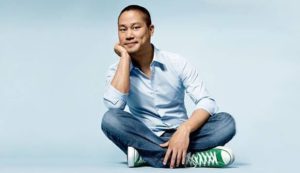
Tony Hsieh’s philosophy was summed up in the book “Delivering Happiness.” Zappos’ legendary customer service made Zappos a $1.2 billion company.
There was shocking news over the Thanksgiving weekend for those of us who are fans of great entrepreneurs.
Tony Hsieh, (pronounced shay) the visionary founder of Zappos and the driving force behind The Downtown Project in Las Vegas, was dead at the young age of 46. Mr. Hsieh succumbed to injuries suffered in a house fire.
Zappos was an early e-commerce success story selling shoes by the truckloads until Amazon came along and scooped up the company for $1.2 billion in 2009.
Hsieh took his fortune and wrote one of the best business books ever “Delivering Happiness” which preached the Zappos philosophy of exceptional customer service. His book and business model influenced scores of entrepreneurs then he pivoted to Las Vegas where he bought a slew of real estate in the old moribund downtown and set about trying to transform the place.
I’ve been following those efforts for years and while the results have met with mixed reviews I deeply admired his vision and audacity.
Transformation is a risky venture. Efforts often fall short but without these special people willing to take risks and buck conventional wisdom change won’t happen.
Within reason, we ought to be encouraging and where possible helping these pioneers who see potential where others see blight.
Hsieh took a boring category (shoes) and created a culture that revolutionized customer service and how to buy a product.
When it came to downtown revitalization, he spent his money and time trying to lure talent and enterprise to a part of Las Vegas long ago written off. The Downtown Project is a $350 million investment: $200 million for real estate, $50 million for tech startups, $50 million for small businesses and $50 million for education, arts and culture.
Noted urban journalist Aaron Renn was a fan of the ambitious effort.
“While I had some critiques of the downtown project, his vision to remake the unbelievably bleak downtown Las Vegas into a hub of creativity was audacity on steroids,” Renn wrote. “ Again, most cities could only dream of having someone with that kind of vision and willingness to attempt the impossible.”
Those “someone’s” are developer/entrepreneurs and I think we make a big mistake when we paint with a broad brush and write them all off as rapacious enemies we must instinctively fight.
As has been noted many times in this space, there are good developers and there are bad ones. We benefit when we can distinguish between the two.
Good developers transform communities. They create places and jobs and they generate vibrancy while growing the tax base.
If we engage them early, we can shape development and make sure projects respect the style and aesthetics of the community. It can be done. But only if we elevate the conversation and work with people not on them.
Attracting good developers to your city is critical of you want to succeed. Avoiding bad ones is equally important.
As for Hsieh, his model called for investing in tech companies in exchange for their promise to relocate to Las Vegas.
He also recruited restaurants, coffee shops and other cool businesses to downtown Las Vegas so that the tech workers who moved there would enjoy a good quality of life.
I thought his approach was fascinating because it tried to be holistic.
He didn’t just build, lease to anyone who showed up and then abandon the place. He curated and stayed around.
He took a long term view and did a huge amount of marketing to promote the vision. He was an evangelist for an old part of Vegas that had been written off as the focus shifted to The Strip.
In more than 30 years of watching local development trends I’ve seen a wide range of development philosophies.
There were those who settled in and did multiple projects while making it a point to give back to the community through service and philanthropy and there were those who acted like strip miners extracting value with little regard to giving back. We make a mistake if we conflate the two types. The former is what you want to attract and nurture, the latter is what you want to avoid.
It’s easy to distinguish who’s who.
Tony Hsieh was the kind of investor you want to attract. Losing him at a young age is tragic.
But he sets an example for those of us who care about our local communities and economies.
There is an opportunity to find and or encourage developers to act as curators to bring desirable uses to our cities.
There is also an opportunity to elevate the conversation around development. The current discourse doesn’t serve anyone and will chase away the visionaries we need to keep our cities vibrant and healthy.
Notes:
Delray Beach lost two community leaders in recent days who will be long remembered for their contributions.
Nadine Hart was a long time community leader, educator and former chair of the TED Center, a local business incubator. She was a guiding light for generations of Delray residents. She was also known for having mentored hundreds of young women in Delray. She will be greatly missed.
John Ingles was a legendary local tennis coach who quietly added immense value to Delray’s tennis community. “Jingles” as he was affectionately known, was a kind man and a trusted advisor for anyone interested in learning about tennis’ potential in Delray. Rest In Peace my friend.
On a happier note, congratulations to Jeffrey Costello who left for the U.S. Marine Corps over the weekend. Jeffrey grew up next store to us in Delray Lakes and has always been a great young man. He was in Junior ROTC at Atlantic High School and has been focused on a military career for quite some time. He’s the pride of our neighborhood and we will be praying for his safety and success.